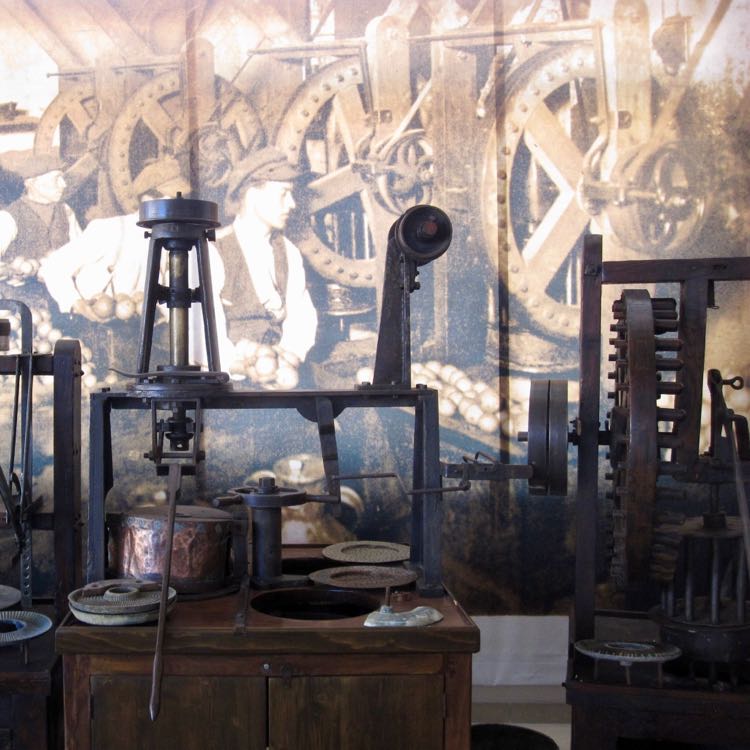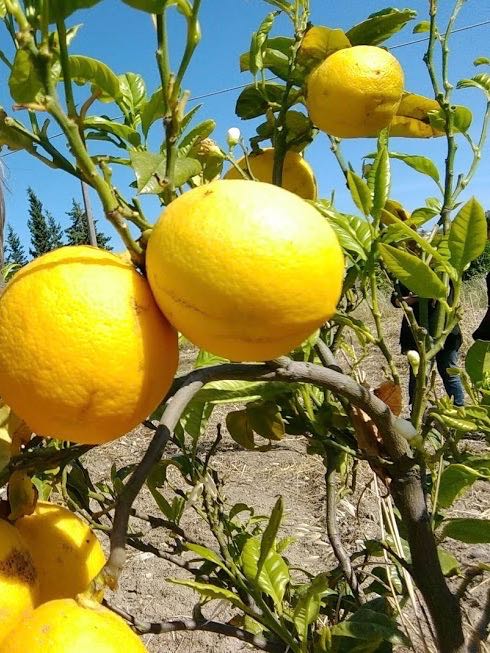People are constantly asking me to give them the highlights of Calabria, to sum it up in a sentence or two. Why should they read my book or scroll through my 100+ blogposts about the region? They want a soundbite, and amongst the myriad of enticements, I’ve found that the bergamot sparks interest. And now, the history of this remarkable citrus fruit from Reggio Calabria can be explored at the city’s Bergamot Museum.
BERGAMOT BASICS
If you don’t know what the bergamot is, I recommend you read my Calabria’s Incredible Bergamot blogpost or better yet, flip to Chapter 10 of Calabria: The Other Italy to catch up. In brief, the unique citrus has been traditionally treasured for the oil pressed from its skin. This delicately fragranced essential oil is an important ingredient in fine perfumes and Earl Grey tea.
The fruit flourishes not in Bergamo, where it doesn’t even grow, but in the Province of Reggio Calabria. Thus, Reggio’s nickname “Bergamot City.” As a guarantee of quality regional products, the European Union has awarded its official PDO (Protected Designation of Origin) status specifically to the Bergamotto di Reggio Calabria (DOP in Italian, Denominazione di origine protetta).
Perhaps this nomenclature sounds like a lot of fuss over a piece of fruit; however, the bergamot truly thrives in the environs of Reggio Calabria and its quality is unparalleled throughout the world. The bergamot’s historical prominence in the fragrance industry has made it significant for the local economy. Of late, the citrus is being lauded for its chemical properties that reduce total cholesterol, lower blood pressure, decrease blood sugar levels and combat fatty liver.
OVER 300 YEARS OF THE BERGAMOT IN REGGIO CALABRIA
The Bergamot Museum tells the story of this special citrus through a display of objects that take the visitor through the traditions and uses of the precious bergamotto di Reggio Calabria. This past year the museum inaugurated a new exhibition space for its collection of artifacts and photos relating to the history of its development and utilizations, together with an area for the presentation and sampling of bergamot products, a library and a large conference room.
Many of the objects in the museum’s holdings were collected and conserved personally by Vittorio Caminiti, president and founder of the Accademia del Bergamotto and the Museo del Bergamotto. My recent visit was led by Francesca Casciano Foti, one of the museum’s extremely knowledgeable docents, who was able to delve into enormous detail with regard to the extensive assortment of tools, machinery and other articles, as well as to present a comprehensive portrait of the fruit, its history and importance for the area.
One particular that really jumped out at me had to do with the value of the bergamot’s essential oil in relation to an anecdote about women’s hair. We’ve all seen pictures of Italian women using their head to carry things. I’ve even seen a few dal vivo (in person). How they manage to balance any weight with such grace is well beyond my elementary school ballet lessons. But now think about the women carrying bergamots from the fields in baskets on their heads. Their hair must have been repositories of the oil’s perfumed scent. And not just the distinctive aroma, but the oil itself, enough to have a sales value so that the oil had to be sponged out of their hair and left at the processing plant.
INDUSTRIAL DEVELOPMENT OF THE BERGAMOT
Sponging by hand was the original method of extracting the essential oil from the bergamot’s skin, and early tools of the trade consisted of a knife to halve the fruit, a tool to scoop out the pulp, a natural sponge and a lipped container.
The museum explores the development of the process from manual extraction through mechanization.
- Spouted basin for bergamot oil
- Historic bergamot tools
- Spouted basin for bergamot oil
Numerous pieces of machinery tell the story of the industrial development, beginning with the 1844 invention of the macchina calabrese by Reggio’s own Nicola Barillà. This “Calabrian machine” greatly increased production as it both quickened the process and guaranteed an oil of superior quality.
Shortly thereafter, a peeling apparatus was introduced, in which the zest was removed with running water and a centrifugal emulsion machine that separated the oil from the water by the weight difference. Thus, the system became completely mechanized, and the process today, while a bit more state-of-the-art follows roughly the same procedure.
MORE AT THE BERGAMOT MUSEUM
The museum has a wide assortment of artifacts, many of which I wouldn’t have expected, such as the array of historic pesticide machines. What did they use to spray? A bergamot mixture, of course! The fruit has so many wonderful properties that the locals have historically known about and put to good use.
A laboratory desk, jars, beakers and scientific equipment testify to the experimentation done with regard to the bergamot.
- Bergamot laboratory
- Bergamot lab equipment
The essential oil was shipped all over the world as in this historic photo with boxes labeled for New York.
And here, I must disappoint the reader that in the sampling area, I completely forgot to take photos of the fragrances (such as the classic “Calabrisella”), the culinary products and the charming articles made from the bergamot’s dried skin, as I was too caught up in the enjoyment of the bergamot liquors to stop and snap a picture.
For your visit, the Museo del Bergamotto or Bergamot Museum is located at via Filippini 50 in central Reggio Calabria. I recommend contacting them ahead of time through the Museo del Bergamotto Facebook page to arrange your tour and learn all about this incredible citrus from Reggio Calabria.
Sbrigatevi! (Get moving!)
Would you like to know more about the bergamot and the fascinating Southern Italian region from where it comes? Check out Calabria: The Other Italy, my non-fiction book about daily life, history, culture, art, food and society in this beautiful region in the toe of the boot. Available in paperback and electronic versions.
When we begin to travel again, come to Calabria with me and sample bergamot products first hand! I will show you the “other Italy.” See the full itineraries on my Calabria tour page.
“Like” Calabria: The Other Italy’s Facebook page and follow me on Karen’s Instagram and Karen’s Twitter for more beautiful pictures and information.
Sign up below to receive the next blog post directly to your email for free.
















Comments 10
This is a beautiful presentation of Calabria and an natural resource of the area. Very educational in its presentation.
Is this fruit….unique? It resembles a lemon, or a lime!
Healing, or therapeutic in nature…..is it available in the US?
Enjoy your emails…..
Author
Glad you enjoyed the post. The bergamot is very unique and also has therapeutic qualities. I wrote about it on my blogpost The Bergamot: Calabria’s Incredible Citrus and there’s a chapter in my book. Bergamot oil and health-related products are available, particularly over the internet, in the US.
Hi Karen – thanks for sharing this inforomation. I didn’t really know what Bergamot was, but I really like Earl Grey tea. I wonder if it’s in Lady Grey?
Author
Yes, bergamot oil is also in Lady Grey – the aroma is very distinctive. As I mentioned in the post, you can find more info on my blogpost about the bergamot and in chapter 10 of my Calabria book. And I also discussed various teas with bergamot oil in my blogpost My Calabrian Tea Party.
I hear from the locals that Bergamots are so good for many things, but I’d never heard of them until arriving in Calabria. So many hidden gems in this gorgeous Italian region.
Great write-up of the museum, which I’m yet to visit.
Author
As you say, the locals have been using the bergamot in many ways for a long time. They have also examined the fruit scientifically. And international studies have also been carried out, such as the Cleveland Clinic’s cholesterol study that determined the “Italian citrus fruit” reduced cholesterol.
This region gets interesting in every post. This fruit is also used in Ayurveda to relieve stress 🙂
Author
The various uses from perfume to food and drink to homeopathic healing to pharmaceuticals is amazing! And relieving stress is always good!
I didn’t know there was a bergamot museum in Reggio Calabria. I need to add this to my “to see” list when I head to the city again. Looks like a really informative and well organized museum.
Author
Yes, the bergamot museum is relatively new in this expanded, official version, and what better place to learn about the bergamot than in the City of the Bergamot, itself?